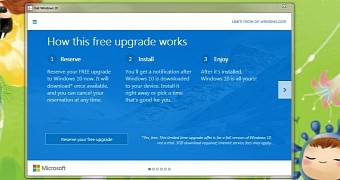Microsoft has often been criticized for how aggressive it was with the free Windows 10 upgrade offer, with some users complaining that the new operating system was installed on their computers even though they refused the upgrade.
One particular moment that fueled all this criticism was when Microsoft changed the behavior of the X button in the Get Windows 10 app, as clicking this button no longer canceled the upgrade, but ignored the setting and prepared the install in the background.
Two “painful” weeks
Chris Capossela, Chief Marketing Officer at Microsoft, said in the latest edition of the Windows Weekly that this was the moment when the company indeed went too far, pointing out that the two weeks between the moment when users started complaining about the unexpected behavior and when a patch was released were “very painful.”
“We know we want people to be running Windows 10 from a security perspective, but finding the right balance where you’re not stepping over the line of being too aggressive is something we tried and for a lot of the year I think we got it right, but there was one particular moment in particular where, you know, the red X in the dialog box which typically means you cancel didn’t mean cancel,” he said.
“And within a couple of hours of that hitting the world, with the listening systems we have we knew that we had gone too far and then, of course, it takes some time to roll out the update that changes that behavior. And those two weeks were pretty painful and clearly a lowlight for us. We learned a lot from it obviously.”
Microsoft offered Windows 10 as a free upgrade during the first year of availability to all Windows 7 and 8.1 users, and the transition was possible with an app called Get Windows 10.
This application, however, sometimes forced the upgrade on some users even though they didn’t want to install Windows 10, leading to growing criticism against Microsoft, who was blamed for trying to boost adoption of its new operating system by ignoring users’ options.

 14 DAY TRIAL //
14 DAY TRIAL // 